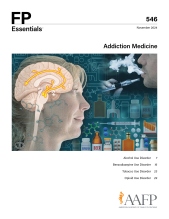
This clinical content conforms to AAFP criteria for CME.
Primary care physicians play an integral role in the identification and management of alcohol use disorder, which has implications for the safety and physical and mental health of patients, their families, and the public. Screening to identify risky drinking behavior is recommended by the US Preventive Services Task Force but is not always performed consistently or correctly in primary care. When alcohol use disorder is identified, collaboration with patients is essential to determine an appropriate treatment approach. Abstinence may not always be the answer. Approximately one-half of patients with alcohol use disorder experience symptoms of alcohol withdrawal syndrome when decreasing alcohol use abruptly or substantially. Physicians must be adept at recognizing and managing signs of alcohol withdrawal. They should be aware of the range of management options and recognize that pharmacotherapy has been underused.
Case 1. KB is a 22-year-old college senior. When you ask about alcohol use, KB states that he drinks three or four beers on weekdays and 10 to 12 beers with shots of hard alcohol on weekends. His grades have slipped, and he jokingly describes himself as a functioning alcoholic. KB’s father and older brother have struggled with alcohol use. KB began drinking as a college freshman to increase his comfort in social situations. He says that he has tried to cut back a couple of times but has resumed drinking within a few days. He recently attempted Sober October and experienced a shaky feeling when not drinking, so he resumed drinking only light beer for the month. Watching his grandfather struggle with health problems, which he thinks may be alcohol-related, has caused him concern about his own long-term health risks, and he feels that he might need help.
Subscribe
From $350- Immediate, unlimited access to FP Essentials content
- 60 CME credits/year
- AAFP app access
- Print delivery available
Edition Access
$44- Immediate, unlimited access to this edition's content
- 5 CME credits
- AAFP app access
- Print delivery available
